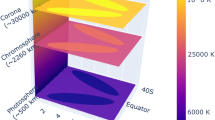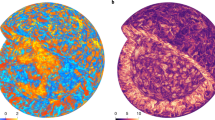Abstract
BOTH Emden's1 old hydrodynamic solar theory and the more modern thermo-hydrodynamical solar theory due to Bjerknes2 lead to a higher temperature at the poles than at the equator of the sun. Bjerknes's theory is, however, more definite as regards the order of temperature difference to be expected. Bjerknes regards the sun as a baroclinic cosmic vortex in which there is a stratified circulation directed from the poles to the equator in the upper photospheric layer and a reverse circulation in the layer immediately below. According to him, sunspots, which he considers also to be vortices, originate in the sub-photospheric stratum; and the depth of a sunspot vortex is connected with the actual difference of temperature between the pole and the equator of the sun. This difference of temperature thus acquires a special importance in solar physics, and therefore an observational determination of this quantity is greatly to be desired. To our knowledge, no measurement of this quantity is so far available. The reason for this lacuna is perhaps to be found in the difficulty of measuring the temperature of the sun with the required degree of accuracy; for the usual methods of measuring the effective temperature of the sun cannot be trusted to give an accuracy greater than ± 400° or 500°. But the temperature difference between the poles and the equator might be of the order of 100° or even less, so that some procedure capable of a higher precision is evidently required.
This is a preview of subscription content, access via your institution
Access options
Subscribe to this journal
Receive 51 print issues and online access
$199.00 per year
only $3.90 per issue
Buy this article
- Purchase on Springer Link
- Instant access to full article PDF
Prices may be subject to local taxes which are calculated during checkout
Similar content being viewed by others
References
“Handbuch der Astrophysik”, 4, 221.
Bjerknes, V., Astrophys. J., 64, 93 (1926).
Woolley, R. v. d. R., Mon. Not. Roy. Astro. Soc., 93, 691 (1933).
Pannekoek, A., B.A.N., 3, 207 (1926); Mon. Not. Roy. Astro. Soc., 91, 139 (1930).
Chandrasekhar, S., Astrophys. J., 102, 395 (1945).
Milne, E. A., Mon. Not. Roy. Astro. Soc., 90, 487 (1930).
Petrie, R. M., Mon. Not. Roy. Astro. Soc., 90, 480 (1930).
Unsöld, A., Z. Astrophys., 2, 209 (1931).
Author information
Authors and Affiliations
Rights and permissions
About this article
Cite this article
DAS, A., ABHYANKAR, K. Difference of Temperature between Pole and Equator of the Sun. Nature 172, 496–497 (1953). https://doi.org/10.1038/172496b0
Issue Date:
DOI: https://doi.org/10.1038/172496b0
Comments
By submitting a comment you agree to abide by our Terms and Community Guidelines. If you find something abusive or that does not comply with our terms or guidelines please flag it as inappropriate.



